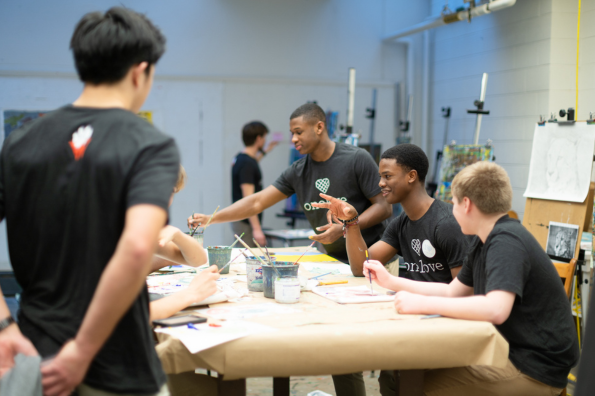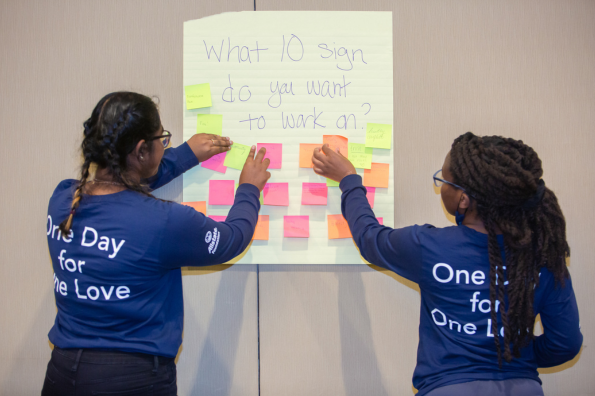There are lots of relationship no-nos but have you ever heard of phubbing? Unlike other unhealthy communication habits, phubbing, the act of snubbing someone by suddenly looking at your phone instead of listening, involves unintentionally ignoring your partner. It usually goes something like this: You meet up with your S.O. for coffee. You start chatting away when ding, a text alert pops up on your partner’s phone and woosh! Your partner stops looking at you and starts looking at their phone. You’ve been phubbed and you’re not alone.
Professors Meredith David and James Roberts of Baylor University’s Hankamer School of Business found that more than 46% of the people they surveyed said they’ve been phubbed by their partners. And almost one-quarter of respondents said that phubbing has led to more fighting and less satisfaction in their relationships. David notes, “Ironically, the very technology that was designed to bring humans closer together has isolated us from these very same people.”
If you aren’t physically phubbing, are you figuratively phubbing? For instance, are you thinking about the email you just received, the text you want to answer, the phone call you’re waiting for or the Instagram photo you want to share? Even if you ditch the phone, and are attempting to listen, are you waiting for your partner to take a breath so you can jump in before the last sentence is even finished?
Clearly, in a world of distractions and bad habits, listening doesn’t come easy.
If you want a close bond with the one you love, it’s time to be present in a whole new way. Whether you are hearing sweet compliments, engaging in an argument, or comparing notes from your day, you will intensify your connection by truly listening and truly hearing your partner. Are you ready to kick this bad habit for good? Start listening!
Use these Two Techniques to Move from Phubbing to Phenomenal!

1. Stay Present by Actively Listening
Everyone’s heard of active listening but did you know it could improve your relationship! Active listening was developed by two psychologists, Dr. Carl Rogers and Dr. Richard Farson, who found that listeners who made eye contact, refrained from judgment, reflected back feelings, asked open-ended questions such as, “tell me more about that,” noticed nonverbal cues, like facial expressions and voice inflections, created a listening environment where openness thrived.
With active listening, you listen without interrupting and without jumping in to comment, fix, or judge. Simple huh? Well, depending on your pattern of communication, this might take some practice and restraint. However, when you listen in this engaging way, you set the stage for deeper and more vulnerable sharing. Even if the conversation is more mundane than monumental, when active listening is used regularly, it can help you and your partner reveal more of yourselves to one another.
Active listening is a great everyday technique. But, for those tough conversations, try the Imago Dialogue.
2. Wait Your Turn Using the Imago Dialogue
I know what you’re thinking. What the heck is the Imago Dialogue! Let me explain: the Imago Dialogue, developed by relationship therapists Dr. Harville Hendrix and Dr. Helen LaKelly Hunt, gives you a chance to approach big issues by participating in a structured conversation. The ground rules are: no one interrupts and each person gets a turn at being the speaker and the listener, phone free! When speaking you can only use “I” statements, such as “I feel like I’m not a priority when you have to work three weekends out of the month” rather than “You never put me first on the weekends!”
Learn 5 Easy Ways to Communicate Better in Your Relationship
Step 1: Choose a Topic
Does it sound impossible to listen without being defensive? Here’s how to do it with the Imago Dialogue. To start the conversation both partners must agree on a topic. This pact helps to keep you from veering off track into other unresolved issues or sneaking a look at your phone. After you’ve both decided on a topic, you can weigh in on who gets to speak first. Then, you are ready to talk!
Step 2: Mirroring

Let say, for example, your partner has been tasked with starting the conversation. Once they’ve shared their feelings, it’s up to you to mirror back what you heard without critiquing their statement. You might say, “I heard you say that you felt like you aren’t a priority for me.” To make sure you mirrored accurately, ask, “Did I get that right?” If your partner says no or wants to further clarify, listen and then mirror again. To close this step, say, “Is there more you want to share?” If there is, let your partner continue to talk while you continue to mirror.
Step 3: Validate Their Feelings
Validating what your partner says will show them that you respect their point of view. To validate a statement, you might say: “What you said makes sense and I can see how you feel that way.” Keep in mind, this step can be tough, especially if your partner is talking about your behavior. As the listener, you are learning about your partner’s truth. The approach is to listen to what you hear with curiosity. As the listener, you are creating two spaces: space for your partner to share and space for you to better understand your partner.
Learn the 10 Signs of a Healthy Relationship
Step 4: Empathize
Lastly, you will empathize with what your partner is sharing by saying something like this, “That sounds really hard…I can imagine you are feeling worried or angry.” This step shows your compassion and capacity to grasp your partner’s feelings. Once you’ve finished this part, it’s your turn to speak. Start from the beginning, but this time you get to be the speaker. The Imago Dialogue might feel overly scripted however, many couples say its structure creates greater understanding.
How To Stop Phubbing aka Phone Snubbing
Ultimately, whether you use active listening or the Imago Dialogue in your relationship, it goes without saying that it’s probably a good idea to avoid looking at your phone while your partner is talking. Phubbing is not just a trendy word for a prevalent issue, it just plain rude. In healthy relationships, couples communicate in a way that makes both partners feel heard and respected. Stay present and mindful while you’re communicating with your partner and your relationship will reap the benefits of greater communication IRL.
Still can’t get your partner to stop phubbing? Ask One Love what to do here.
Browse by Category

How to Have Healthy Holiday Conversations with Family (and Prep Your Partner)
The holidays are a time for family, good food, and—let's be real—sometimes intense conversations. Whether it's politics, lifestyle choices, or…
How to End a Summer Romance or Friendship
Summer flings and friendships can feel fleeting. So why is…
Celebrate Your Freedom: Independence in Relationships
As Independence Day rolls around, let’s chat about something just…
Practicing Equality in Your Relationships
Equality is one of One Love’s 10 Signs of a…
How to Practice Allyship Using the 10 Signs
During the month of June the United States observes both…














